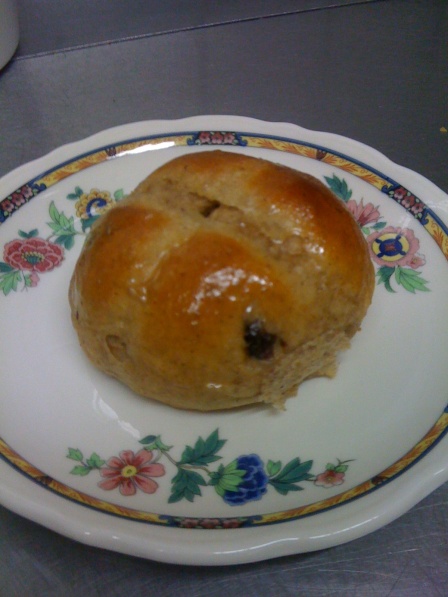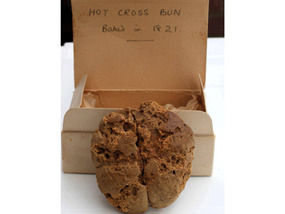After our little brother A Salt & Battery’s easter offering, we felt we had to follow suit, but with something a little more traditional. A bigger deal in England than over here, like any good celebration, Easter is accompanied by its own repertoire of culinary delights. Top amongst them for many (certainly ourselves!) is the hot cross bun. Sweet, spiced, yeasty balls of dough, punched through with sultanas, marked with a cross and baked to sticky perfection; these yummy buns are delightful cut in half, toasted and buttered.
For such small buns, they come with a great deal of superstition and mythology. It is traditionally said that the cross represents Jesus, and explains the association with Easter. Indeed, Elizabeth David – a queen of traditional British cookery – points to the fact that Queen Elizabeth I (with a capital ‘Q’) banned the baking of hot cross buns “except it be at burials, or on Friday before Easter, or at Christmas”. Most bizarre of all is the belief that hot cross buns are good omens; improving cooks’ skills, preventing fires and warding off rats and weevils. One family has kept a bun in a box since 1821!
We really look forward to freshly baking these little morsels from our traditional recipe. If you want to make them at home, we recommend fabulous food writer Felicity Cloake‘s recipe. It comes after meticulous consideration of various approaches – which you can read here. It’s a tough job but someone’s got to do it! She says these are perfect – and we believe her!
Hot Cross Buns
Makes 16
200ml milk, plus a little more for glazing
3 cardamom pods, bruised
1 cinnamon stick
2 cloves
¼ tsp grated nutmeg
Pinch of saffron
20g fresh yeast
50g golden caster sugar, plus extra to glaze
450g strong white flour
100g butter
½ tsp salt
½ tsp ground ginger
3 eggs
150g currants
50g mixed peel
3 tbsp plain flour
- Heat 200ml milk gently in a pan along with the cardamom, cinnamon, cloves, nutmeg and saffron until just boiling, and then turn off the heat and leave to infuse for 1 hour. Bring back up to blood temperature and then mix the strained milk with the yeast and 1 tsp sugar.
- Tip the flour into a large mixing bowl and grate over the butter. Rub in with your fingertips, or in a food mixer, until well mixed, and then add the rest of the sugar and the salt and ginger. Beat together 2 of the eggs.
- Make a well in the middle, and add the beaten eggs and the yeast mixture. Stir in, adding enough milk to make a soft dough – it shouldn’t look at all dry or tough. Knead for 10 minutes until smooth and elastic, then lightly grease another bowl, and put the dough into it. Cover and leave in a warm place until it has doubled in size – this will probably take a couple of hours.
- Tip it out on to a lightly greased work surface and knead for a minute or so, then flatten it out and scatter over the fruit and peel. Knead again to spread the fruit around evenly, then divide into 16 equal pieces and roll these into bun shapes. Put on lined baking trays and score a cross into the top of each, then cover and put in a warm place to prove until doubled in size.
- Pre-heat the oven to 200C and beat together the last egg with a little milk. Mix the plain flour with a pinch of salt and enough cold water to make a stiff paste. Paint the top of each bun with egg wash, and then, using a piping bag or teaspoon, draw a thick cross on the top of each. Put into the oven and bake for about 25 minutes until golden.
- Meanwhile, mix 1 tbsp caster sugar with 1 tbsp boiling water. When the buns come out of the oven, brush them with this before transferring to a rack to cool. Eat with lots of butter.



